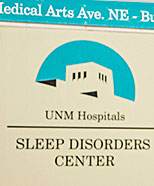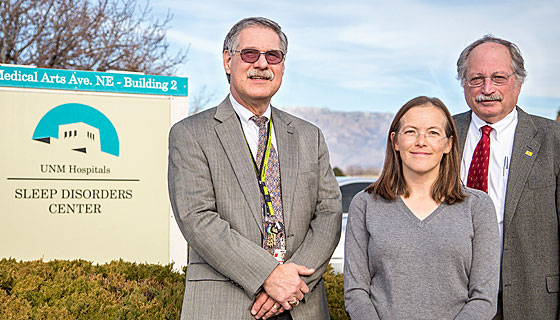Recent News
NQVL Design Phase Award
October 1, 2025
CHTM Joins NSF's NQVL Pilot Projects
August 9, 2024
OSE PHD, Dr. Xuefeng Li - Wins The Outstanding Interdisciplinary Graduate Programs Award
May 10, 2024
Dr. Ali Rastegari - 2024 OSE Best Dissertation Award Winner
May 10, 2024
News Archives
First of its Kind: Smart Lighting Installed in Hospital Inpatient Setting
January 13, 2016 - Sharon Steely
“Smart Lighting” inpatient Hospital Room completed at UNM Health Center

A hospital room at UNM HSC has been equipped with lighting that can be precisely tailored and continuously adjusted in brightness and the color spectrum.
Researchers at the University of New Mexico (UNM) and the Smart Lighting Research Center (ERC) at the Rensselaer Polytechnic Institute (RPI) collaborated on the project. (The Smart Lighting ERC has since been rebranded as Lighting Enabled Systems and Applications— LESA.) Installation of the unique combination and integration of computer sensors, lighting controls, and LED lighting system was recently completed.
The computer-controlled lighting system can mimic the diurnal and seasonal variations of natural outdoor light and other customized qualities. Researchers at UNM will use the facility to conduct studies regarding the treatment of circadian rhythm disorders and health conditions such as depression, Parkinson’s disease, and other neurological diseases that have been shown to respond to light exposure of the correct spectrum, intensity and timing.
“Not only will this new technology allow us to study classic circadian rhythm sleep-wake disorders, but now we will also be able to investigate the effect light plays on such behavioral health disorders as depression and dementia,” said Lee K. Brown, M.D., Professor of Internal Medicine and Electrical and Computer Engineering, as well as Medical Director of the UNM Health System’s Sleep Disorders Programs.

Lee K. Brown, MD; Meeko Oishi, PhD; Steven R. J. Brueck, PhD
“The sensors in the testbed can also be used to determine occupancy in the room,” said Steven R. J. Brueck, PhD, UNM Distinguished Professor Emeritus of Electrical and Computer Engineering, UNM Lead for the Smart Lighting Engineering Research Center, and emeritus director of the Center for High Technology Materials. He added, “the system can collect feedback on variables ranging from the number and position of room occupants to the test subject’s sleep/wake patterns, and even alert a nurse’s station if a patient falls – all without the need for cameras with their associated privacy issues.”
The installation was funded by the National Science Foundation’s Engineering Research Center (ERC) program through the Smart Lighting ERC housed at RPI.
UNM partners with RPI to conduct research for the next generation of lighting systems and their applications, or “Smart Lighting Systems that See and Think™.” This installation is a clone of an existing smart lighting test bed that is in a conference room setting at RPI.
“We have found this collaboration to be extremely productive. There are only 20 active NSF ERCs nationwide. These are large-scale projects (~ $4M/yr) intended to both advance technology for societal needs and to train students in the collaborative research modes they will need to master for work in industry. UNM Engineering currently participates in four ERCs,” said Brueck. “We believe this is the first hospital room where you can control light in a meaningful way,” he said.
"At UNM, Associate Professor Meeko Oishi, PhD, Department of Electrical and Computer Engineering, and her research group worked with RPI and HSC faculty and staff to customize the lighting system to fit HSC research needs," said Brueck.
Research has shown that people are sensitive to different colors of light at different times of the day and that sleep phases can be adjusted by exposure to certain colors and intensities of light. "Ultimately, we want to be able to help people control their circadian phase through lighting," said Oishi.
First Study using this New Resource to Benefit “Night Owl” College Students
The first research study involving the specially-equipped room will investigate whether individuals with delayed sleep-wake phase disorder (“night owls”), a condition common to college students, can be treated by varying the spectrum of light they are exposed to throughout the day. "Other potential research areas range from hospital-induced conditions such as post-operative delirium and ICU psychosis, to the effects of light on the sleep patterns of patients receiving chemotherapy or those suffering from depression," said Brown.
“In the future, everyone may have access to this technology. Knowing more about the effects of lighting may actually help physicians to prevent disease and increase productivity in healthy persons," said Brown.
Collaborators on the Smart Lighting Hospital Room at UNM HSC:
Smart Lighting ERC
Funded primarily by the National Science Foundation, the Smart Lighting ERC is an interdisciplinary, multi-university center developing “Smart Lighting Systems that See and Think™."
Rensselaer Polytechnic Institute
Founded in 1824, RPI is the nation's oldest technological university.
UNM Health Sciences Center Program in Sleep Medicine
The program combines state-of-the-art outpatient sleep laboratories at University Hospital and Sandoval Regional Medical Center, an inpatient sleep laboratory, sleep medicine clinics, and trained medical and technical staff dedicated to the diagnosis and treatment of sleep/wake disorders in adults and children.
UNM Health Sciences Center
Research investigators at the University of New Mexico Health Sciences Center are committed to the mission of conducting basic and clinical research that will significantly impact the health of communities in New Mexico, as well as making significant contributions in healthcare worldwide.
UNM Center for High Technology Materials (CHTM)
CHTM was one of 5 Centers of Technical Excellence established by the State of New Mexico in 1983. It is internationally recognized as an outstanding research center in photonics and microelectronics.
Story updates:
Smart Lighting Hospital Room is ready for sleep studies
Group behind "Smart Lighting" Hospital Room reunites at IES meeting


